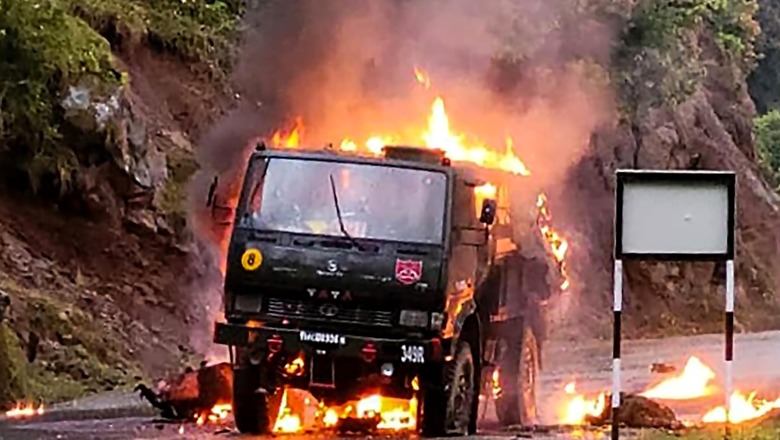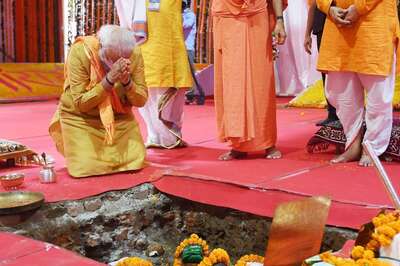
views
Residents of Sangiote village in Jammu and Kashmir’s Poonch district did not celebrate Eid. The village was the destination of the army truck of 49 Rashtriya Rifles, which was ambushed on April 20, leaving five soldiers dead and one critically injured. Four of these soldiers were from Punjab and one from Odisha. The vehicle was carrying fruits and other items from the Bhimber Gali Camp for an iftar gathering meant to be held in Sangiote later that evening.
According to reports, invitations had gone out to several people in the village for the event at 1900 hours, and arrangements were being taken care of by the 49 Rashtriya Rifles (RR). Unfortunately, a shadow group of the Jaish-e-Mohammed (JeM), People’s Anti-Fascist Front (PAFF) that carried out this deadly attack during the holy period, had other plans. The terrorists took advantage of the terrain, treacherous stretch of road and bad weather and, as per reports, used Chinese-origin steel core ammunition that created a terrible incendiary fallout leading to the death of these brave hearts.
The PAFF emerged after the abrogation of Article 370 and they are now threatening to carry out attacks at the G20 venues in Srinagar and Leh. It is believed that seven to eight terrorists were involved in this attack. This little-known group has been morphed from JeM and is a ploy to avoid sanctions under the Financial Action Task Force (FATF).
Massive search and combing operations are ongoing in Bhata Dhurian-Tota Gali and neighbouring areas to hunt down the terrorists involved in the attack. Bhata Dhurian is a notorious infiltration route for terrorists from across the Line of Control (LoC) because of its topography, dense forest cover and natural caves. Special Forces and National Security Guard are also engaged in the operation in the dense forest areas. It is being said that drones, sniffer dogs and metal detectors are also being used. On April 26, a man was detained by the Security Forces who admitted that he “sheltered” the terrorists for two months and provided them support. The Northern Army Commander, Lieutenant General Upendra Dwivedi, while taking stock of the ongoing operation, during a visit to Poonch and Rajouri has ‘asked the troops to be relentless in their pursuit’.
The terrorists reportedly hid themselves in a culvert on this road stretch before attacking the vehicle. Over 50 bullet marks have been found on the vehicle that shows the intensity of the firing. During the search operation, troops came across a few natural cave hideouts in the area, which could possibly have been used by the terrorists in the past, they said, adding the troops are also looking for any improvised explosive devices (IEDs) terrorists may have planted in the densely forested areas, especially in deep gorges and caves.
Significance of The Attack
The attack has significance in the context of the G20 Tourism Working Group meeting to be held in J&K next month. The ambush also took place soon after the announcement that Pakistan Foreign Minister Bilawal Bhutto will attend the Goa meeting of the Foreign Ministers’ Council of the Shanghai Cooperation Organisation (SCO). The aim naturally being to derail these events.
In the past also, any positive movement in India-Pakistan relations has invited a terrorist response. Clearly, the perpetrators of the attack and their handlers from across the border must be hoping to throw a spoke into India’s plan of hosting these meetings and thereby deny India a larger global role. However, such cowardly actions need not deter the nation as we cannot afford to let terror groups hold us hostage.
A terror incident also restores the image of J&K as a conflict zone. That, in turn, might lend Pakistan some badly needed credibility on its Kashmir narrative. There are updates already about the fact that these terrorists had local support and had been in the area for some time spreads a false narrative that the locals resent the Indian Army.
The region where this gruesome incident took place was relatively freer of insurgency ever since the intensive operations launched in 2003 by Romeo Force. It came into the spotlight of terrorist groups after the revocation of Article 370 as they seek to regain a foothold in the valley by trying to lure forces’ attention towards the Jammu region. Hence the targeted killings of seven civilians took place in Rajouri in January this year.
There is no doubt that Pakistan is sliding into an abyss. There is a looming political and economic crisis. The armed secessionist movement in Baluchistan has become active again. The Afghan Taliban keeps violating the Durand Line. The Tehrik-e-Taliban Pakistan (TTP) has virtual autonomy in the Khyber Pakhtunkhwa (KPK) Province. With life returning to normal in J&K, Pakistan saw itself pushed into a corner, hence attacks like this helped shift the focus elsewhere. It saw a window of opportunity to carry out such an attack as it perceives risks of retaliation are low as India is presently focussed on hosting major diplomatic events.
The Pakistani leadership must bear in mind that cross-border terrorism is the single most important issue that needs to be tackled for the normalisation of bilateral ties. Incidents like these merely widen the trust deficit. Unfortunately, incidents like this reinforce the fact that their willingness to prosecute a proxy war has not abated.
Need To Draw Relevant Lessons
Of course, there are lessons to be learnt and these are at all levels, from tactical drills to the operational and strategic levels. Fingers, unfortunately, are being pointed at the Army with Amarjit Singh Dulat, former head of RAW, stating that “the army has clearly dropped its guard.”
While there is no doubt that a single vehicle, moving at 1500 hours without adequate protection and area sanitation in the form of road opening, does throw up certain questions regarding complacency that may have set in. The truth is that an Army operating in a risk-prone and challenging operational environment can, at best, minimise mistakes, but these cannot be completely eliminated. The strength and professionalism of the Armed Forces lie in learning lessons from these mistakes and not repeating them.
Apart from planned retaliatory measures for dominating the escalatory ladder, the concentration is now on apprehending and eliminating those involved in the attack. The essence initially lies in quickly detecting threats and neutralising them by means available at the formation level. Thereafter, the Army will no doubt carry out detailed inquiries, analyse the incidents and draw relevant lessons from them and enforce remedial measures.
Intelligence is another area which needs to be looked into. The responsibility of which is not only the domain and charter of the Army but also of the state and central police agencies operating in the region.
The Larger Military Strategy of Our Adversary
These killings reinforce the larger military strategy of our adversary who has repeatedly demonstrated that it is unwilling to abandon targeted violence in achieving its objectives, their words and deeds had parted ways long before.
The timing of this has been chosen to coincide with the important diplomatic events being hosted as the terrorists and their handlers feel we will not be able to respond reflexively. Immediate inaction may tear at our conscience but we retain the right to respond. The place, timing and manner of response is, of course, best left to those in authority and uniform. To quote Leonard Cohen: “I don’t believe that this world can afford pacifism. I think pacifism delights the hearts of killers.” Fortunately, the response to Pulwama has demonstrated that we are now willing to use hard power.
While writing on this incident, Lieutenant General Ata Hasnain has talked about India’s ‘strategic confidence and its ability to handle sensitive and tricky foreign policy and security challenges’ but has also cautioned that ‘the old threats that seemed to have been neutralised are back’.
Low-Intensity Conflict has the ability to linger on, it just doesn’t disappear but it must not allow it to bounce back. While there is no doubt that the steps taken with regard to the abrogation of Article 370 were long overdue and in the right direction, unfortunately, the public and media perceptions seemed to indicate that ‘terror had been contained’ by this move and ‘normalcy restored’. Whereas the threat from Pakistan, in spite of its numerous and widening fault lines, has not vapourised.
Pakistan, of course, has seen the growing hostility between India and China as an opportunity. The conflict on the LAC, particularly after Galwan in 2020, forced a shift in India’s focus towards its Northern borders and consequent rebalancing of formations and resources thereby reducing the conventional threat towards Pakistan and diluting the counter-insurgency grid South of the Pir Panjals. This has been beneficial to Pakistan and is an issue that needs to be addressed by a balanced deployment.
India’s Security Challenges
The security challenges faced by India are hybrid, conducted in many battle spaces by multiple means, including without any direct attribution and any overt physical military application of combat power. A collusive hybrid threat from both China and Pakistan remains a security challenge. To counter this, we need strong deterrence and a quid pro quo capability.
Much of strategic thinking has been dominated by the need for deterrence and our ability to win a conventional war with our Western adversary. However, today’s reality is that direct high-intensity conflicts may not be fought as per the previous template. The focus, though shifting to multi-domain operations, will be on non-contact warfare, including terror incidents, cyber-attacks, and economic, legal and proxy wars.
Collusivity also manifests itself in many forms, it can be direct or indirect, visible or invisible. Troops can fight alongside, or support can be rendered by other means from supplying arms and ammunition, intelligence inputs to satellite imageries and of course, support in international forums. The continuing Chinese standoff on our Northern borders which compelled us to recalibrate our posture by diverting troops and resources from South of the Pir Panjals can also be considered a form of collusivity.
The major players will prefer to be invisible, and it is in this grey zone that we are likely to see greater collusion. The anti-India collusive hybrid threat dilemma will get compounded in the times to come and this is what we need to be prepared to counter.
(The author is an Army veteran. The views expressed in this article are those of the author and do not represent the stand of this publication)
Read all the Latest Opinions here


















Comments
0 comment